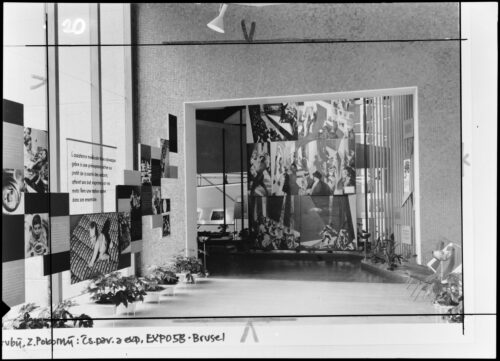Czechoslovak pavilion at Expo 58, Brussels
For their competition-winning project at Expo 58, the trio of František Cubr (1911–76), Josef Hrubý (1906–88), and Zdeněk Pokorný (1909–84) designed a uniquely simple building: three solid, massive-looking blocks connected by two long glass corridors. The soft curve of the restaurant was inscribed within the courtyard, and a monumental sculpture—a suspended Kaplan turbine—welcomed visitors to the pavilion. As a structurally lightweight building with steel truss columns and beam trusses along with a concrete-panel-and-glass curtain wall, this elegant pavilion fully captured the period’s International Style. Entitled ‘One Day in Czechoslovakia’, the exhibition concept developed by Jindřich Santar accentuated the narrative of the everyday, structured according to the divisions of the ordinary workday: work, rest, and culture. The pavilion was awarded the gold medal for best pavilion and for featured exhibition.
The pavilion also presented Laterna Magika, an intermedia film-theatre performance conceived by Josef Svoboda and Alfréd Radok. In a highly original way, it combined film with live theatre, including song, dance, music, and pantomime, with the multiscreen projection synchronized to the actors who were performing and interacting with the film’s content. The Brussels ‘non-stop programme’, comprising twenty-six paintings, was repeated three times a day for the entirety of the fair, amounting to 365 repetitions in total. Additionally, the exhibition featured the ‘polyekrán’, a film projection onto eight screens simultaneously, on which associative images alternated with musical accompaniment.
Countries: Czech Republic
Tags: Architecture, Media

